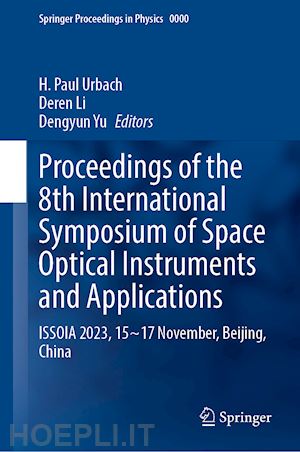
Questo prodotto usufruisce delle SPEDIZIONI GRATIS
selezionando l'opzione Corriere Veloce in fase di ordine.
Pagabile anche con Carta della cultura giovani e del merito, 18App Bonus Cultura e Carta del Docente
This proceedings volume contains selected and expanded contributions presented at the 8th International Symposium of Space Optical Instruments and Applications, held in Beijing, China on 15~17 November, 2023. The symposium was organized by the Sino-Holland Space Optical Instruments Joint Laboratory and supported by Beijing Institute and Space Mechanics and Electricity.
In recent years, space optical payloads are advancing towards high spatial resolution, high temporal resolution, high radiometric resolution, and high spectral resolution and becoming more and more intelligent. Commercial remote sensing industry has made steady progress in terms of the scope of satellite systems and applications. Meanwhile, space optical remote sensing data has been extensively applied to monitoring of resources, meteorology, ocean, environment, disaster reduction, and many other fields.
The symposium focused on key innovations of space-based optical instruments and applications, and the newest developments in theory, technology and applications in optics, in both China and Europe. It thus provided a platform for exchanges on the latest research and current and planned optical missions.
The major topics covered in these conference proceedings include but are not limited to:
1) Advanced optical technology and new remote sensing technology for space applications;
2) Advanced optical material technology and space application;
3) Advanced photoelectric converter technology and space application;
4) Space optical instruments and applications for deep space exploration and astronomical observation;
5) Ecological environment space optical instrument and its application; and
6) Commercial space optical remote sensing technology and services.
Paul Urbach graduated in 1981 at the University of Groningen, the Netherlands, and completed in 1986 a Ph.D. thesis at the same university on the optimization of hydrodynamic propulsion. In 1986, he joined Philips Research Laboratory in Eindhoven, the Netherlands. During 1980, he spend four months in Signetics Research Laboratory in Sunnyvale, California, the USA, where he worked on optical lithography. In 1994, he became a principal scientist at Philips Research Laboratory. In 2000, he became a part-time professor in diffraction optics at Delft University of Technology (TUDelft), the Netherlands. Since January 2008, he is a full professor and the head of the Optics Research Group of TUDelft. He has been President of the European Optical Society 2012-2014 and 2017-2018, member of the Advisory Board of the Dutch Minister of Economic Affairs on metrology and Scientific Director of the Dutch Optics Centre.
Deren Li, born in December 1939, is an Academician of the Chinese Academy of Sciences, the Chinese Academy of Engineering, the International Eurasian Academy of Sciences (IEAS), Corresponding Academician of the International Academy of Astronautics (IAA) and Honorary Member of the International Society for Photogrammetry and Remote Sensing (ISPRS). Li, also a professor of Wuhan University and a PhD supervisor, is the director of the Academic Committee of Wuhan University, the director of the Academic Committee of the State Key Laboratory of Information Engineering in Surveying, Mapping and Remote Sensing, and the director of the Collaborative Innovation Center of Geospatial Technology. He has been the director-general of the Chinese Society for Geodesy Photogrammetry and Cartography, vice director of the China Society of Image and Graphics, vice director of the Association of Environment Remote Sensing of China (AERSC), founding president of the Asia GIS Association, and president of Committee III and VI of the International Society for Photogrammetry and Remote Sensing. He is also a member of the National Aerospace Expert Group, deputy leader of the National Key Program for Science and Technology Development--"High-resolution Earth Observation System", member of the Sixth Science & Technology Commission of the Ministry of Education and member of the Strategic Research Committee. He has won one National Science and Technology Progress Award (Innovation team), four Second Prizes of the National Science and Technology Progress Awards and two National Higher Education Teaching Achievement Prizes (1st place).
Dengyun Yu, deputy director of the China Aerospace Science and Technology Corporation CST. He has long been engaged in systematic designing of spacecraft, theoretical research of dynamic, development of analysis software, and related organization and management work. He has participated in, or organized the analysis and research about the impact dynamic of spacecraft, the vibration mechanics of remote sensing satellite, the dynamic of manned spacecraft docking in space, the complex dynamic of space station and so on, where he achieved substantial achievements.











Il sito utilizza cookie ed altri strumenti di tracciamento che raccolgono informazioni dal dispositivo dell’utente. Oltre ai cookie tecnici ed analitici aggregati, strettamente necessari per il funzionamento di questo sito web, previo consenso dell’utente possono essere installati cookie di profilazione e marketing e cookie dei social media. Cliccando su “Accetto tutti i cookie” saranno attivate tutte le categorie di cookie. Per accettare solo deterninate categorie di cookie, cliccare invece su “Impostazioni cookie”. Chiudendo il banner o continuando a navigare saranno installati solo cookie tecnici. Per maggiori dettagli, consultare la Cookie Policy.